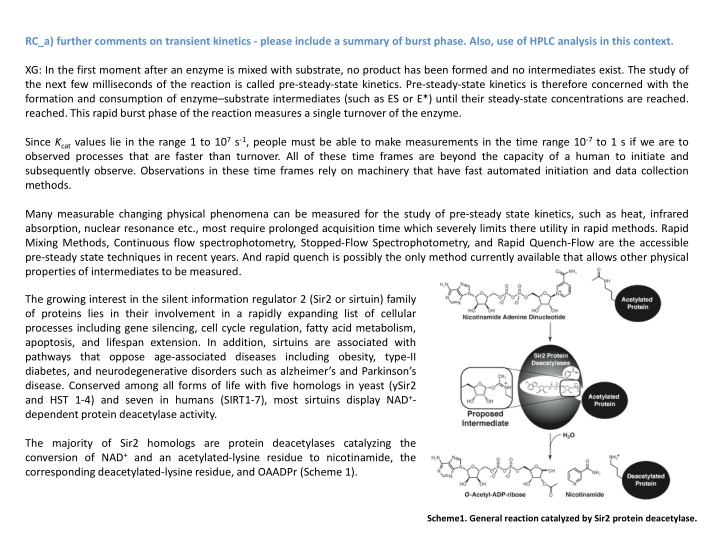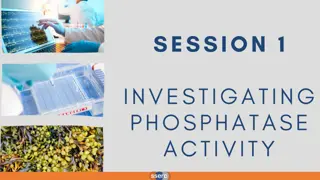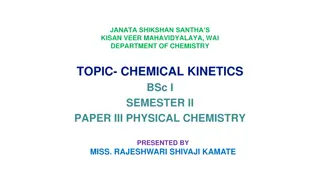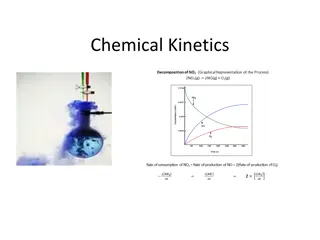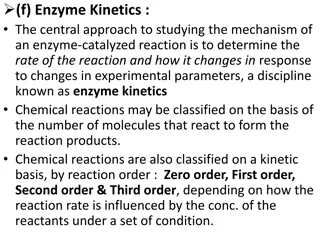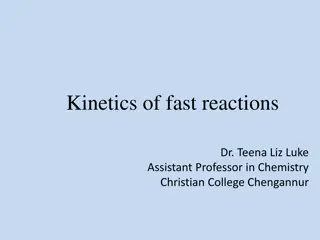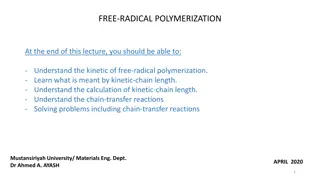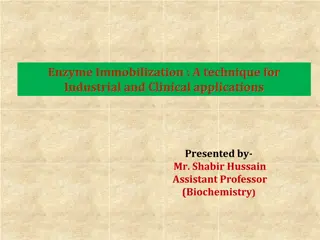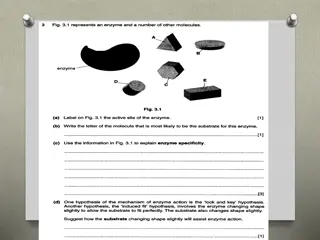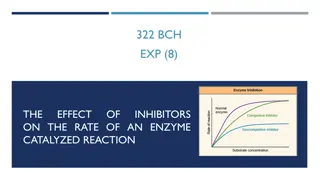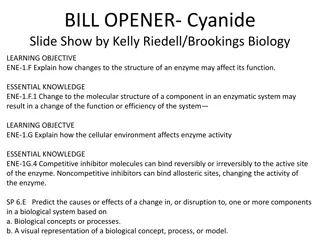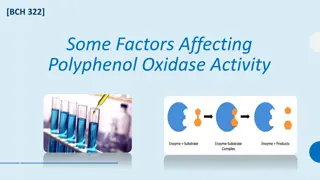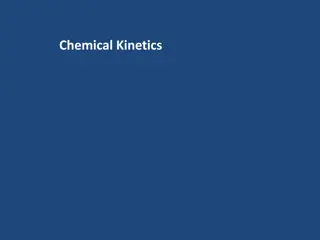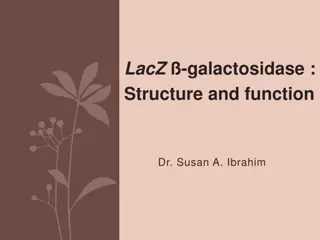Overview of Pre-Steady-State Kinetics in Enzyme Reactions
Pre-steady-state kinetics is essential for studying transient stages in enzyme reactions, such as the burst phase. Techniques like rapid quench-flow and HPLC analysis provide insights into enzyme-substrate interactions. The Sir2 protein family, including SIRT1-7, plays crucial roles in cellular processes and age-related diseases through NAD+-dependent deacetylase activity.
Download Presentation

Please find below an Image/Link to download the presentation.
The content on the website is provided AS IS for your information and personal use only. It may not be sold, licensed, or shared on other websites without obtaining consent from the author.If you encounter any issues during the download, it is possible that the publisher has removed the file from their server.
You are allowed to download the files provided on this website for personal or commercial use, subject to the condition that they are used lawfully. All files are the property of their respective owners.
The content on the website is provided AS IS for your information and personal use only. It may not be sold, licensed, or shared on other websites without obtaining consent from the author.
E N D
Presentation Transcript
RC_a) further comments on transient kinetics - please include a summary of burst phase. Also, use of HPLC analysis in this context. XG: In the first moment after an enzyme is mixed with substrate, no product has been formed and no intermediates exist. The study of the next few milliseconds of the reaction is called pre-steady-state kinetics. Pre-steady-state kinetics is therefore concerned with the formation and consumption of enzyme substrate intermediates (such as ES or E*) until their steady-state concentrations are reached. reached. This rapid burst phase of the reaction measures a single turnover of the enzyme. Since Kcat values lie in the range 1 to 107 s-1, people must be able to make measurements in the time range 10-7 to 1 s if we are to observed processes that are faster than turnover. All of these time frames are beyond the capacity of a human to initiate and subsequently observe. Observations in these time frames rely on machinery that have fast automated initiation and data collection methods. Many measurable changing physical phenomena can be measured for the study of pre-steady state kinetics, such as heat, infrared absorption, nuclear resonance etc., most require prolonged acquisition time which severely limits there utility in rapid methods. Rapid Mixing Methods, Continuous flow spectrophotometry, Stopped-Flow Spectrophotometry, and Rapid Quench-Flow are the accessible pre-steady state techniques in recent years. And rapid quench is possibly the only method currently available that allows other physical properties of intermediates to be measured. The growing interest in the silent information regulator 2 (Sir2 or sirtuin) family of proteins lies in their involvement in a rapidly expanding list of cellular processes including gene silencing, cell cycle regulation, fatty acid metabolism, apoptosis, and lifespan extension. In addition, sirtuins are associated with pathways that oppose age-associated diseases including obesity, type-II diabetes, and neurodegenerative disorders such as alzheimer s and Parkinson s disease. Conserved among all forms of life with five homologs in yeast (ySir2 and HST 1-4) and seven in humans (SIRT1-7), most sirtuins display NAD+- dependent protein deacetylase activity. The majority of Sir2 homologs are protein deacetylases catalyzing the conversion of NAD+ and an acetylated-lysine residue to nicotinamide, the corresponding deacetylated-lysine residue, and OAADPr (Scheme 1). Scheme1. General reaction catalyzed by Sir2 protein deacetylase.
Previous studies have focused on the complete steady-state kinetic mechanism the inherent differences in catalytic efficiency and substrate preference among Sir2 enzymes (ySir2, yHST2, and SIRT2) for various histone peptides the overall kinetic mechanism Resolve the individual chemical steps of the Sir2 reaction. However, very few studies of pre-steady state kinetic of the Sir2 reaction have been reported. In 2004, it was reported that Sir2-like (HST2 and SIRT2) enzymes follow a sequential mechanism. Using rapid-quench analysis with HST2, the authors have provided the first direct kinetic evidence of multistep acetyl group transfer, with the kinetic resolution of an ADP-ribose-like intermediate. Sir2-like enzymes (HST2 and SRIT2) follow a sequential mechanism, where binding of both NAD+ and acetylated substrate forms a ternary complex that is required prior to any chemical step. The competitive inhibition displayed by H3 against AcH3 suggests that H3 is the last product released and AcH3 is the first to bind. AcH3 can bind to the enzyme but NAD+ alone cannot, which indicated the idea that the acetylated substrate is the first to bind. After formation of the ternary complex, NAM is cleaved at a rate of 7.3 s-1, and subsequent formation of OAAPr occurs at 1.3 s-1. NAM is the first product released by the enzyme, based on the ability of the sir2 enzymes to catalyze a [14C]nicotinamide-NAD+ exchange reaction in the absence of the other two products. Both the enzyme-OAADPr and enzyme-deacetylated binary complex can form during the reaction, suggesting that there is randomness in the release of the deacetylated product and OAADPr. The noncompetitive inhibition of the deacetylated product, histone H3 peptide, vs. NAD+ suggests the existence of an enzyme- OAADPr complex, where binding of H3 to this complex in addition to binding to the free enzyme would result in the observed noncompetitive inhibition. ADP-ribose, carba-NAD+ as dead-end inhibitors, can bind to an enzyme-deacetylated product complex.
To determine the rates of nicotinamide and OAADPr formation were determined under single-turnover conditions using a Rapid- Quench device. Rate of NAM formation: [14C]NAD+ was used as a substrate, and the formation of the [14C]-NAM was monitored between 10.3 - 8000 ms. Then concentration of NAM was determined by calculating the percentage of total radioactivity in the NAM fraction and the initial [14C]NAD+ concentration. Rate of OAADPr formation: [3H]AcH3 was used as a substrate and the reactions were carried out between 60 and 1500 ms. The concentration of OAADPr was determined from the percentage of total radioactivity found in OAADPr and the initial [3H]AcH3 concentration. A syringe containing Hst2 and NAD+ was rapidly mixed with another syringe containing the acetyl-lysine peptide analogs. Both syringes contained Tris buffer and DTT. Radioactivity of fractions collected via reverse-phase HPLC was determined by scintillation counting To obtain the rate constant (k), the plot of product concentration formed over time was fitted to a single-exponential equation (Eq. 1) ? = ?0 (1 ? ??) (1) Where P is the concentration of product formed, [S]0 is the initial concentration of the limiting substrate, and t is the reaction time. Note: After formation of the ternary complex, nicotinamide is cleaved at a rate of 7.3 s-1 and subsequent formation of OAADPr occurs at 1.3 s-1. The rate of nicotinamide formation does not fit perfectly to a single-exponential equation. The observed slowing of nicotinamide formation near the end of the reaction is explained by the fact that cleavage of the nicotinamide ribosyl bond is a highly reversible step. As nicotinamide accumulates, it can condense with an enzyme- ADP- ribose-like intermediate to re-form NAD+, resulting in the progressive slowing of nicotinamide formation. This explanation was verified using the kinetic simulation programSpecfit. From this simulation analysis, the rate of nicotinamide formation must be relatively fast, with a rate of "10- 20 s-1. The rate at which nicotinamide condenses with the enzyme-ADP-ribose-like intermediate must be comparable to the forward rate. Previously, this was shown to be "3 s-1. Therefore, the trend in the data can be described by the efficient reversibility of this portion of the reaction. Rates of nicotinamide (open square) and OAADPR formation (solid circle).
References Rusche, L. N., Kirchmaier, A. L., and Rine, J. (2003) The establishment, inheritance, and function of silenced chromatin in Saccharomyces cerevisiae. Annu Rev Biochem 72, 481-516. Gasser, S. M., and Cockell, M. M. (2001) The molecular biology of the SIR proteins. Gene 279, 1-16. Dryden, S. C., Nahhas, F. A., Nowak, J. E., Goustin, A. S., and Tainsky, M. A. (2003) Role for human SIRT2 NAD-dependent deacetylase activity in control of mitotic exit in the cell cycle. Mol Cell Biol 23, 3173-85. Starai, V. J., Celic, I., Cole, R. N., Boeke, J. D., and Escalante-Semerena, J. C. (2002) Sir2-dependent activation of acetyl-CoA synthetase by deacetylation of active lysine. Science 298, 2390-2. Vaziri, H., Dessain, S. K., Ng Eaton, E., Imai, S. I., Frye, R. A., Pandita, T. K., Guarente, L., and Weinberg, R. A. (2001) hSIR2(SIRT1) functions as an NAD-dependent p53 deacetylase. Cell 107, 149-59. Luo, J., Nikolaev, A. Y., Imai, S., Chen, D., Su, F., Shiloh, A., Guarente, L., and Gu, W. (2001) Negative control of p53 by Sir2 promotes cell survival under stress. Cell 107, 137-48. Langley, E., Pearson, M., Faretta, M., Bauer, U. M., Frye, R. A., Minucci, S., Pelicci, P. G., and Kouzarides, T. (2002) Human SIR2 deacetylates p53 and antagonizes PML/p53-induced cellular senescence. Embo J 21, 2383-96. Kaeberlein, M., McVey, M., and Guarente, L. (1999) The SIR2/3/4 complex and SIR2 alone promote longevity in Saccharomyces cerevisiae by two different mechanisms. Genes Dev 13, 2570-80. Rogina, B., and Helfand, S. L. (2004) Sir2 mediates longevity in the fly through a pathway related to calorie restriction. Proc Natl Acad Sci U S A 101, 15998-6003. Tissenbaum, H. A., and Guarente, L. (2001) Increased dosage of a sir-2 gene extends lifespan in Caenorhabditis elegans. Nature 410, 227-30. Haigis, M. C., and Guarente, L. P. (2006) Mammalian sirtuins--emerging roles in physiology, aging, and calorie restriction. Genes Dev 20, 2913-21. Smith, J. S., Brachmann, C. B., Celic, I., Kenna, M. A., Muhammad, S., Starai, V. J., Avalos, J. L., Escalante-Semerena, J. C., Grubmeyer, C., Wolberger, C., and Boeke, J. D. (2000) A phylogenetically conserved NAD+-dependent protein deacetylase activity in the Sir2 protein family. Proc Natl Acad Sci U S A 97, 6658-63. Landry, J., Slama, J. T., and Sternglanz, R. (2000) Role of NAD+ in the deacetylase activity of the SIR2-like proteins. Biochem Biophys Res Commun 278, 685-90. Smith BC and Denu JM. Acetyl-lysie analog peptides as mechanistic perobes of protein deacetylases. JBC(2007) 282:37256- 37265. Smith BC and Denu JM. Sir2 deacetylases Exhibit nucleophilic participation of acetyl-Lysine in NAD+ cleavage. JACS (2007) 129: 5802-5803. Borra, MT et al. Substrate specificity and kinetic mechanism of the Sir2 family of NAD+-dependent histone/protein deacetylases. Biochemistry (2004) 43: 9877-9887.
RC(6/3/14)_b) looking up pathways whereby sirtuin inhibition can alleviate metabolic or neurodegenerative disease. RC (6/9): Here are some articles on the disease applications of sirtuin inhibitors; most refer to SIRT1. Neurodegenerative diseases appear to be a prime target, with Ex-527 apparently in trials for HD. We need to review this (note preclinical animal models used by Elixir for HD) and summarize main points, and check whether anyone is targeting SIRT3, given that it is a "double-edged sword". XG: Neurodegeneration is the process by which neurons are lost due to genetic and environmental stressors. There are many types of neurodegenerative diseases, which affect different populations of neurons and cause a range of untreatable symptoms; the most common types are Alzheimer disease, Parkinson disease, amyotrophic lateral sclerosis (ALS), and Huntington disease. The central risk factor for neurodegeneration is advanced age. Sirtuins have been implicated in neurodegenerative diseases due to their reputation as aging, stress response genes and due to the fact that they are highly expressed in the brain and central nervous system. Upregulation of SIRT1, through CR protocols or resveratrol administration, was shown to be beneficial in AD models in rodents, and in a small scale clinical studies involving Alzheimer s patients. Contrarily, inhibition of SIRT2 was shown to be effective in model systems recapitulating Parkinson s disease (PD) and Huntington s disease (HD). It appears that targeting sirtuins in the context of neurodegenerative diseases can (i) delay the accumulation of misfolded proteins and (ii) by alleviating oxidative stress, prevent altogether the formation of misfolded proteins, providing a preventive therapeutic measure. The insights into the 7 mammalian sirtuins therapeutic targets will be discussed following the outline below (Priorities are in dark read). Sirtuins in the Nucleus SIRT1 SIRT6 SIRT7 Sirtuins in the Mitochondria SIRT3 SIRT4 SIRT5 Sirtuins in the Cytoplasm SIRT2
SIRT1, Pharmaceutical and nutriceutical interferences targeting SIRT1 are promising strategies to combat aging-associated diseases. Neurodegenerateive diseases Parkinson s disease (PD) is one of the most common progressive neurodegenerative disorders, affecting about 2% of people over 65 years old and 4% of people over 85. PD is characterized by a loss of dopaminergic neurons in the substantia nigra, which is accompanied by muscle rigidity, bradykinesia, resting tremor and postural instability. Resveratrol + quercetin (Activators) prevented the decrease of dopaminergic neurons. Alzheimer s disease (AD) / AD Tauopathies is one of the most devastating age-related neurodegenerative diseases. The increased life expectancy of human beings has made AD one of the predominant medical problems for elderly people. AD is related to abnormal protein accumulation so-called tauopathies characterized by the presence of filamentous protein aggregates in neurons. Resveratrol and Activation of SIRT1 promote neuronal survival. SIRT1-expressing lentivirus Amyotrophic lateral sclerosis (ALS) is a devastating human motor neuron disorder. SIRT1-expressing lentivirus Huntington s disease (HD) is caused by accumulation of a mutated form of the neuronal protein huntingtin, or Htt. Ex-527: Elixir Pharmaceuticals reported (01/08/2010) that its partner (Siena Biotech) had commenced Phase I testing of Elixir sSIRT1 inhibitor. Cancer SIRT1 inhibition as an anticancer strategy Sirtinol administration induced senescence-like growth arrest in lung cancer cells and MCF-7 human breast cancers cells. Salermide induced tumor-specific cell death in a variety of human cancer cell lines derived from leukemia, lymphoma, colon and breast primary malignancies. Tenovins behaves as p53 activators through inhibition of the SIRT1/2 deacetylase activity. SIRT1 activation as an anticancer strategy
SIRT1 contd Cardiovascular diseases Coronary artery disease Acute coronary syndromes Metabolic diseases Type 2 diabetes SRT1460 (activator) SRT1720 (activator) SRT2183 (activator) diabetic nephropathy Attenuate cisplatin-induced renal cell injury
Mitochondria are the main organelles in the cell that are responsible for energy balance and metabolism. They have been implicated in several human diseases, and an important hypothesis has emerged that mitochondrial dysfunction is associated with the onset of age- related disorders and cancer. Cancer_Double-Edged Sword Cancer is a widespread, heterogeneous disease that is the leading cause of death worldwide. It is characterized by oxidative damage, which then leads to metabolic imbalance within the cell, abnormal macromolecule production, and uncontrolled tumor growth. It has been shown that oncogenes, such as Ras, Akt kinase, and Myc, promote metabolic processes such as glycolysis and glucose uptake. As mitochondrial sirtuins have emerged as metabolic regulators, they are being studied intensely for their possible roles in cancer progression. SIRT3, a key mitochondrial deacetylase, seems likely play some roles as both tumor promotor and tumor-suppressor. SIRT3 has been shown to be prosurvival, preventing cell death in response to stress and starvation. SIRT3 has also been shown to protect from cell death in response to hypoxia or the apoptotic inducer staurosporine. These studies support the general role of sirtuins in promoting longevity, but it also might indicate a role in tumor growth. Indeed, SIRT3 has been shown to promote cell proliferation in oral cancer cell lines and to block the growth arrest function of the transcription factor p53 in bladder cancer cells. SIRT3 gene expression levels are also increased in malignant human breast biopsies. SIRT3 has been identified as a tumor suppressor in several studies, which directly link SIRT3 to metabolic processes. The loss of SIRT3 in mouse embryonic fibroblasts (MEFs) was first shown to induce tumor growth in response to oncogene expression. SIRT3 expression in MEFs was also shown to destabilize HIF1 , a transcription factor that promotes glycolytic metabolism as dictated by the Warburg effect. SIRT3 might also prevent cancer by deacetylating and activating mitochondrial superoxide dismutase (MnSOD), which is thought to control the levels of ROS and prevent oxidative damage that triggers cancer pathology. Since SIRT3 is involved in many aspects of cellular metabolism, including fatty acid oxidation, amino acid catabolism, and oxidative phosphorylation, its role in cancer is likely to be complex and multidimensional. Different stimuli and environmental effects seem to trigger different responses from SIRT3, and it will be interesting to determine which external stimuli will trigger specific regulatory roles of SIRT3.
Neurodegeneration Mitochondria are also implicated in aging processes as their function declines. Therefore, mitochondrial sirtuins present promising targets to study in deducing the pathology of neurodegeneration. SIRT3 is known to deacetylate many substrates in the mitochondria that are important to metabolic processes, but this has mainly been shown in other tissues besides the brain. In general, SIRT3 displays protective effects against ROS production by upregulating SOD function. Since ROS have been shown to induce neurodegenerative processes, SIRT3 might be protective in neurons against ROS-related damage. SIRT3 was first shown to be protective against excitotoxic injury in primary neuron cultures. SIRT3 was shown to be neuroprotective in response to Alzheimer disease induced cellular stress in addition to ROS-induced injury. Possible mechanisms for SIRT3 upregulation in response to neuronal stress include interaction with the FOXO3 transcription factors. SIRT3 has been shown to interact with FOXO3a, but the physiological implications, especially in the context of neurodegeneration, are not clear. FOXO3 transcription factors are thought to offer protection from oxidative stress by activating detoxifying genes such as catalase and MnSOD. In addition, while FOXO3 may function as a tumor suppressor in other tissues, its role in apoptosis has implications for sirtuin-mediated neurodegeneration. More studies are needed to determine whether SIRT3 can be neuroprotective through its interaction with FOXO3a or if there is another mechanism involved. Clinical trials on SIRT3?
SIRT2 AK-7 (inhibitor) is neuroprotective in HD mouse models Genetic inhibition of SIRT2 rescued -synuclein toxicity, modified inclusion morphology and protected dopaminergic cell death in cellular and fly models of PD
Summary of major clinical trials with mitochondrial target therapeutic agents in PD and HD
Summary of major clinical trials - Cont d
